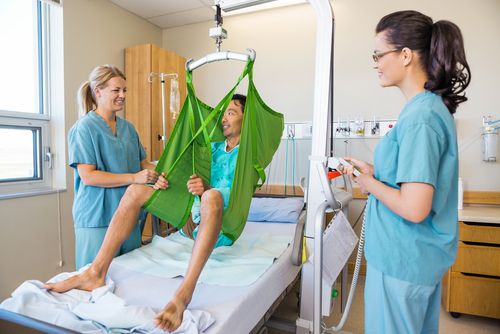 Written by Phillip McMullen II, MD, PhD
Written by Phillip McMullen II, MD, PhD
Patient lifts are an indispensable tool in most healthcare settings, both residentially and clinically. Lifts help eliminate the risk of injury associated with manual lifting and transfer procedures. However, even with the use of a hoist, accidents and injuries are always a possibility. For this reason, it is important to employ safe lifting practices at all times.
Patient lifts are assistive devices that are used to transfer patients from the toilet, shower, bathtub, bed, a chair, or virtually any other location. They utilize either hydraulic or electrical power to safely lift and transfer a patient from one surface to another, supporting their full body weight and eliminating the need for manual lifting. If you are caring for someone with limited mobility, having a patient lift can dramatically reduce the risk of injuries to both you and the individual.
Several different types of patient lifts are available, each designed to be highly effective for different applications.

One of the best ways to reduce the risk of accidents and injuries while using a patient lift is to select the right equipment. Make sure that you have purchased the right type of lift for your needs, and be sure to check that the lift and sling has an appropriate weight capacity. If the individual will be lifted with any accessories or other equipment, make sure that you incorporate the weight of these items into your calculations as well.
Before you attempt to move anyone with your patient lift, you need to understand how to operate it safely. Spend some time becoming familiar with how the lift works, and practice using it without anyone in the sling. Try to find a training video or manual either online or from the manufacturer, and review it carefully.
A damaged sling puts the patient at risk of falls and injury. Before each use of your lift, take some time to inspect the sling and its straps for any signs of damage or wear. If the sling is damaged, replace it before using the patient lift again.
When using a lift for your patient, it is essential to make sure that the patient is calm, comfortable, and prepared for the transfer. A patient who is upset or unwilling to remain still raises the risk of an accident. It is also important to make sure the patient is positioned properly within the sling and that their arms are safely inside the sling's straps.
All fastening components of the hoist, including hanger bars, latches, and clips, should be securely locked in place anytime you use it. Check each of these components before you begin operating the lift to help reduce the risk of dangerous accidents.
If you’re using a floor lift of any type, including standing lifts, make sure that you check any wheels on the base before beginning the transfer. Make sure the wheels are locked into place during the lifting process. Otherwise, the device may move during the transfer, destabilizing the patient and raising the risk of an accident.
If you are using a floor lift to transfer a patient, make sure that the lift's legs remain open to the widest point where possible. This maximizes the stability of the device and improves its ability to support the patient, reducing the risk of an accident.
Failing to properly maintain the patient lift and all of its components can increase the risk of a malfunction or a fall. Create a maintenance checklist that includes instructions for inspecting all of the equipment's components on a regular basis. As soon as you see signs of a problem, replace the component in question.
When used properly, a patient lift can be an asset to any caregiver of a patient with limited mobility. By following these tips, you can lower the risk of injuries to both you and your patient during transfers.
For more information on patient lifts and how to choose the best lift for your needs, check out the rest of our great articles on Caregiver University. You can also browse the full selection of highly effective medical equipment and innovative assistive devices at Rehabmart.com.

Phillip spent his childhood and undergraduate years in Southern Ohio, where he attended Miami University. After receiving his bachelor’s degree from this institution in 2008, he moved to Chicago to attend medical school at the University of Illinois. Phillip graduated from medical school in 2016 with his Ph.D. and M.D. He is currently completing a residency in pathology. Together, Phillip and his wife have three children. When Phillip isn’t practicing medicine, he enjoys researching and writing about a variety of topics in the medical field. He also enjoys traveling, hiking, and playing games with his family.